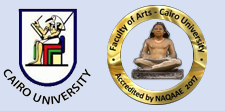عنوان المقال عربي
تناص قصيدة "تاج المُلک" لـ "دافيد بن زيمرا" مع "کتاب الخليقة": دراسة نقدية مقارنة
Document Type
Editorial
Abstract English
The term "the kingly crown" refers to many of the Hebrew poetic works, that bear this name, both in the middle age, and in the modern age. The poem "the kingly crown" written by the poet, writer, and Jewish philosopher "Solomon Ibn Gabirol" is the first poem bearing this name."David Ibn Zimra" was inspired the title of his poem "the kingly crown", that influenced primarily by the thought of Kabbalah, which made the “sefer yetzira” (book of creation) the cornerstone, from title of the poem "the kingly crown" by "Solomon Ibn Gabirol", who influenced by modern Platonism."David Ibn Zimra" was famous kabbalist in the sixteen century, and was very famous in the kabbalah study; this was clear in his poem "the kingly crown", which deals with several ideas specific to the kabbalists: the ten divine manifestations, the description of God, the role of Hebrew letters in the creation of the world.So, the study found that the intertextuality theory is the most appropriate theory to study and to determine the content and influences that affected them.The study begins with the introduction of the Kabbalah ideas, and the reasons that helped in the emergence of this intellectual trend, so that the reader can understand some of the concepts and terminology in Kabbalah though, and in the "sefer yetzira", who inspired by "David Ibn Zimra" in his poem.Then, preface deals with the definition of "sefer yetzira", and the most important topics in it, the definition of Rabbi "David Ibn Zimra", and his poem "the kingly crown".The study is divided into three parts: the first part deals with the concept of text and intertextuality in western, Arabic, and Hebrew dictionaries and cultures, and then highlights on the importance of deeply reading of literary texts, so that the underlying codes can be revealed.The second part deals with the Kabbalah ideas, which are mentioned in the "sefer yetzira", and "Ibn Zimra" was inspired in his poem as idea of the ten divine manifestations, and idea of God’s manifestation through the pronouns of the absent, the addresser, and the speaker.The third part deals with how "Ibn Zimra" calls in his poem the idea of Hebrew letters, and its role in building the world, which appeared in the "sefer yetzira".In finally, the study reviews the main findings, which reached it.
الملخص العربي
الملخصيشير تعبير "تاج المُلک כתר מלכות" إلى الکثير من الأعمال الشعرية العبرية التي -تحمل هذا الاسم سواء في العصر الوسيط أو في العصر الحديث. فقصيدة "تاج المُلک" التيکتبها الشاعر والأديب والفيلسوف اليهودي "سليمان بن جبيرول" هي أولى القصائد التيتحمل هذا الاسم. وقد استلهم "דוד בן זמרא دافيد بن زيم ا ر" عنوان قصيدته اولتي أطلق –عليها أيضًا مسمى "تاج المُلک כתר מלכות" موضوع الد ا رسة من مسمى قصيدة "تاج المُلک" -ل "سليمان بن جبيرول" الذي تأثر بالأفلاطونية المحدثة، ولکن قصيدة "دافيد بن زيم ا ر" متأثرهفي المقام الأول بفکر القبالاه، الذي جعل "کتاب الخليقة" حجر الأساس له .وکان "ردباز" من قبالي صفد البارزين في القرن السادس عشر، وقد ذاع صيته فيد ا رسة القبالاه ، وهذا بات واضحًا في قصيدته )تاج المُلک( التى تتناول عدة أفکار خاصةبالقبالاه منها: التجليات الإلهية العشرة، ووصف الإله، ودور الحروف العبرية في خلقالعالم. وقد أ رت الد ا رسة ان نظرية التناص هي أنسب نظرية لد ا رستها والوقوف علىمضمونها وعلى المؤث ا رت التي أثرت فيها.وتبدأ الد ا رسة بمقدمه تتناول تعريف فکر القبالاه، و الأسباب التي ساعدت في نشأةهذا الاتجاه الفکري، حتى يتسنى للقارىء إد ا رک بعض المفاهيم والمصطلحات الخاصة بالفکرالقبالي التي استلهمها "دافيد بن زيم ا ر" في قصيدته من "کتاب الخليقة".
Recommended Citation
Ahmed, Amal Hashem Sayed
(2020)
"Intertextuality in poem "the kingly crown" for "David ibn zimra" with "sefer yetzira"
Comparative critical study,"
Journal of the Faculty of Arts (JFA): Vol. 80:
Iss.
2, Article 7.
DOI: 10.21608/jarts.2020.100114
Available at:
https://jfa.cu.edu.eg/journal/vol80/iss2/7
Digital Object Identifier (DOI)
10.21608/jarts.2020.100114
Accept Date
2019-07-02
Publication Date
4-1-2020

